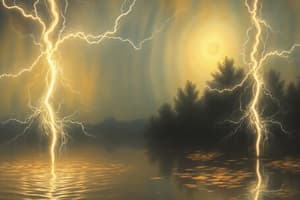Podcast
Questions and Answers
The voltage difference between two bodies is called the potential difference (PD) and is measured in ______.
The voltage difference between two bodies is called the potential difference (PD) and is measured in ______.
volts
Resistance is a property that opposes ______ flow.
Resistance is a property that opposes ______ flow.
current
Resistance is directly proportional to the length of any conductor and inversely proportional to its ______ area.
Resistance is directly proportional to the length of any conductor and inversely proportional to its ______ area.
cross-sectional
The current in a circuit is inversely proportional to the ______ of the circuit.
The current in a circuit is inversely proportional to the ______ of the circuit.
Heating a conductor to a temperature sufficiently high that it causes the conductor to give off electrons is called ______ emission.
Heating a conductor to a temperature sufficiently high that it causes the conductor to give off electrons is called ______ emission.
Conduction of current in a vacuum is much more difficult to achieve because there are no gas molecules which can liberate free ______.
Conduction of current in a vacuum is much more difficult to achieve because there are no gas molecules which can liberate free ______.
Electrons are emitted from a cathode by ______ emission (heating of conductor) and stream across to the plate (anode) because of electrostatic attraction.
Electrons are emitted from a cathode by ______ emission (heating of conductor) and stream across to the plate (anode) because of electrostatic attraction.
Edison's bulb had a vacuum so the filament would glow without burning. Also, the space between the filament and plate was relatively small. The electrons emitted from the filament did not have far to go to reach the plate. Thus, the positive charge on the plate was able to attract the negative ______.
Edison's bulb had a vacuum so the filament would glow without burning. Also, the space between the filament and plate was relatively small. The electrons emitted from the filament did not have far to go to reach the plate. Thus, the positive charge on the plate was able to attract the negative ______.
The key to this explanation is that the electrons were floating free of the hot filament. It probably would have taken hundreds of volts to move electrons across the space if they had to be forcibly pulled from a cold filament. Such an action would destroy the filament and the flow would cease. Edison’s application of thermionic emission in causing electrons to flow across the space between the filament and the plate has become known as the ______ effect.
The key to this explanation is that the electrons were floating free of the hot filament. It probably would have taken hundreds of volts to move electrons across the space if they had to be forcibly pulled from a cold filament. Such an action would destroy the filament and the flow would cease. Edison’s application of thermionic emission in causing electrons to flow across the space between the filament and the plate has become known as the ______ effect.
Metallic conductors contain many free electrons, which at any given instant are not bound to atoms. These free electrons are in continuous motion. The higher the temperature of the conductor, the more agitated the free electrons, and the faster they move. A temperature can be reached at which some of the free electrons become so agitated that they actually escape from the conductor. They 'boil' from the conductor's ______.
Metallic conductors contain many free electrons, which at any given instant are not bound to atoms. These free electrons are in continuous motion. The higher the temperature of the conductor, the more agitated the free electrons, and the faster they move. A temperature can be reached at which some of the free electrons become so agitated that they actually escape from the conductor. They 'boil' from the conductor's ______.
The process is similar to steam leaving the ______ of boiling water.
The process is similar to steam leaving the ______ of boiling water.
What will happen when an uncharged pith ball is brought near a positively charged rod?
What will happen when an uncharged pith ball is brought near a positively charged rod?
What happens once the rod and the pith ball exhibit like electrostatic charges?
What happens once the rod and the pith ball exhibit like electrostatic charges?
According to the triboelectric series, how are materials ranked?
According to the triboelectric series, how are materials ranked?
What is true about the behavior of a rubber object when charged?
What is true about the behavior of a rubber object when charged?
What can be predicted based on the position of materials in the triboelectric series?
What can be predicted based on the position of materials in the triboelectric series?
What happens when one part of a balloon is rubbed with wool?
What happens when one part of a balloon is rubbed with wool?
What is the relationship between materials higher on the triboelectric series and the charge they acquire?
What is the relationship between materials higher on the triboelectric series and the charge they acquire?
Who first discovered and wrote about the relationship between attracting or repelling charged bodies?
Who first discovered and wrote about the relationship between attracting or repelling charged bodies?
What is the general term used to describe any atoms that are connected by chemical bonds?
What is the general term used to describe any atoms that are connected by chemical bonds?
Which type of compound is made of atoms from different elements?
Which type of compound is made of atoms from different elements?
What type of forces hold together compounds that can conduct a current?
What type of forces hold together compounds that can conduct a current?
Which compound is an example of matter in which all the molecules are identical but comprised of different atoms in exact proportions?
Which compound is an example of matter in which all the molecules are identical but comprised of different atoms in exact proportions?
Flashcards are hidden until you start studying




